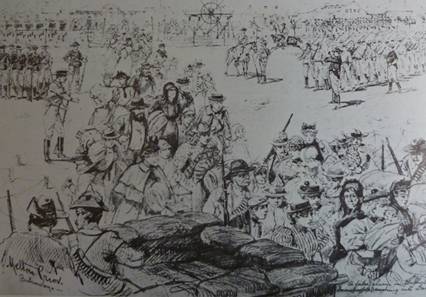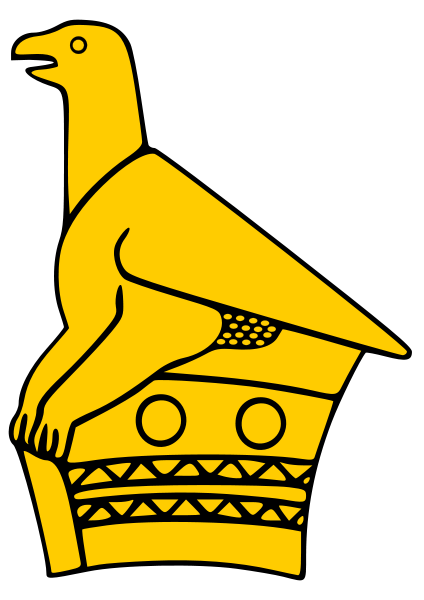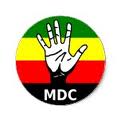Pioneer Days
Who saw action first?
Gifford reacted to Cumming's report of the handful of whites laagered at his store. Gifford raised a force of 40 men to ride to their relief; by the time he arrived, 38 men, a women and a child had crowded into Cumming's two makeshift buildings. Gifford reinforced what he could with sandbags and built a thorn fence around the two buildings to protect the horses and waited for something happen. As the faintest streaks of light glimmered in the sky the next day (ilanga izimpondo), Msindazi led his men in a fierce attack on the store, coming at it from three sides and gaining the very walls of the wooden house. By sun up the Matabele were driven away, some having been killed at the windows their arms outstretched to grab their victims inside. Gifford immediately decided that he would lead his motley crew back to Bulawayo, starting the journey at 0630 and arriving in Bulawayo a nervous three days later. In Gifford's absence, Napier had ridden out to rescue people in the area of the Umgusa and Tekwe Rivers, arriving back in Bulawayo on April 1 with 50 people. Such successes were not to be repeated for a long time.

Sketch of the layout of Cumming's store by Gifford.
What was Bulawayo's status at this time?
From a few grass huts and iron sheds, Bulawayo had grown into a town with many respectable stone and wooden buildings. Around 1400 white men and 800 white women were in the town by March 1896 and during the course of the siege and later military campaigns about 2000 blacks lived within the town limits. Around 800 men were fit for military duties, although in terrible irony only 400 rifles (albeit with 1,500,000 rounds) could be found to equip them and less than 100 horses to form any sort of cavalry. One of the prime newspapers, the Bulawayo Sketch is full of dark humor about both the course of the war and the actions its citizens. (The Sketch, created by Alexander Davis and Joseph Boam on July 21, 1894 ceased production on July 24, 1897 and has the distinction of being the first newspaper in the country to be regularly illustrated). As it reported in March, not all of Bulawayo's citizens were likely to inspire confidence as many had never handled a gun before; one was seen trying to force cartridges down the muzzle of his rifle while anther anxiously asked passers-by if it was safe to carry live bullets in his hand. Nevertheless, the Bulawayo Field Force was created (initially it was known as the Rhodesia Horse Volunteers) and placed under the command of John Spreckley, notwithstanding his sojourn to Filabusi at the time.
The Fear...

A rush for the safety of the laager in Bulawayo after the alarm was sounded.
Rumours abounded in Bulawayo in the last week of March. The three military men in whom the citizens had most confidence - Spreckely, Napier and Gifford - had ridden out of town, the man nominally in charge - Duncan - was aloof and incommunicative. As Ransford (1968: 88) relates it was the actions of a drunken rider galloping through town screaming about the advance of the Matabele after hearing a careless rifle shot that brought white Bulawayo's "single lapse". Macfarlane, quoted in Ransford, wrote that the whites "scrambled and fought for what rifles were left in the Government Store" and herded the women and children into hastily erected strongholds. The most notable of these was the Bulawayo Club, whose sacrosanct halls had hitherto been denied to the fairer sex. Ransford claims the irony of this situation was that the Club had been planning to celebrate its opening with a ladies night but is contradicted by Gibbs (1970: 26-27) who could find no record of any plans in the Club minutes. Hensman (1900) continues the story: "Had a rush on the town been made by the rebels that night, when the confusion and the clamour were at their height, the consequences would have been too awful to contemplate, and would have vied with anything that the blood-stained pages of the Indian Mutiny can show".
Sourced from the Zanj Financial Network 'Zfn', Harare, Zimbabwe, email briefing dated 28 March 2011


 South Devon Sound Radio
South Devon Sound Radio Museum of hp Calculators
Museum of hp Calculators Apollo Flight Journal
Apollo Flight Journal Apollo Lunar Surface Journal
Apollo Lunar Surface Journal Cloudy Nights Classic Telescopes
Cloudy Nights Classic Telescopes The Savanna - Saffer Shops in London
The Savanna - Saffer Shops in London Linux Mint
Linux Mint Movement for Democratic Change
Movement for Democratic Change